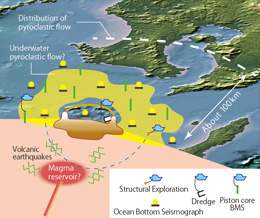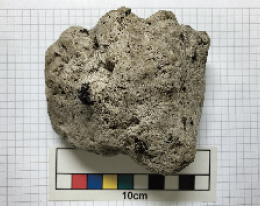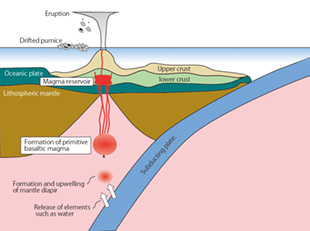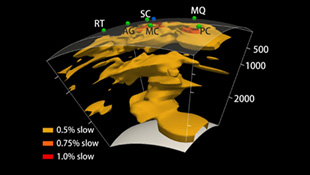Volcanoes and Earth’s Interior Research Center (VERC)
Developing an integrated understanding of volcanic activity and the Earth’s interior
Earth is a continuously changing planet and volcanoes play a major part in shaping both its land and marine landscapes. The dynamic activity of volcanoes is an awesome sight, yet, we often suffer from disasters caused by them. Ultimately, the energy of volcanic activities is supplied from the Earth's interior. Our center is aiming to develop an integrated understanding of volcanoes and Earth's interior, and making the best use of this knowledge for the benefit of our society.
- 2025/04/25
- Observation of a remote island volcano by an unmanned helicopter taking off from a research vessel and operated remotely via satellite communications (flash report)
- 2025/03/17
- Recruitment of Senior Researcher, Researcher or Researcher (II) (CKS25-001)
- 2024/08/22
- Exploration of the accumulation of magma in Kikai Caldera from the Chikyu submarine cores
- 2024/05/31
- Recognized as Top Cited Article
- 2024/05/17
- Recruitment of Senior Researcher, Researcher or Researcher (II) (CKS24-002)
- 2023/07/19
- A theoretical model of continental drift reveals that the longest timescale of sea level change in Earth's history can be explained by the flattening effect of the seafloor
- Toward an understanding of the relationship between Earth's internal dynamics and surface environmental change - - 2023/05/25
- Did a coalition of giant volcanoes occur in the Pacific Ocean?
New evidence for the Ontong Java Nui hypothesis - 2023/04/26
- Recruitment of a Senior Researcher, Researcher or Researcher (II) (CKS23-003)
- 2022/07/15
- The recent research paper of Dr. Iona M. McIntosh has been published in Nature as a Research Highlight
- 2022/06/30
- Revealing past eruptions of Oomurodashi volcano, an active submarine volcano 60 km from Tokyo Bay
- 2022/06/03
- Recruitment of a Senior Researcher or Researcher (Ⅱ) (CKS22-001)
- 2020/11/12
- Solid Earth Geochemistry Research Group, Recruitment of Postdoctoral Researcher (CGP20-007)
- 2020/07/10
- FY2020 Solid Earth Geochemistry Research Group, Recruitment of Postdoctoral Researcher CGP20-007
- 2019/11/18
- Recruitment of Principal Scientist or Principal Technical Scientist (CKS-007)
- 2019/08/08
- FY2020 Recruitment of Scientist or Technical Scientist (CKS-001)
- 2019/07/18
- JAMSTEC People “Interview with Dr. Iona McIntosh”
- 2019/05/16
- Volcanoes and Earth’s Interior Research Center (VERC) website has been launched.
Exploring the present state of oceanic volcanoes.
 Ongoing surveys at Kikai Caldera.
Ongoing surveys at Kikai Caldera.Kikai Caldera experienced huge eruptions in the past. We are exploring the structure by various methods and reconstructing the eruption history.
 Drifted pumice erupted from Fukutoku-Oka-no-Ba, 2021.
Drifted pumice erupted from Fukutoku-Oka-no-Ba, 2021.We are exploring the mechanism of eruption by analyzing these samples.
Studies on oceanic volcanoes, such as submarine volcanoes and volcanic islands, is far behind those on volcanoes located on land. Consequently, there are concerns that unexpected eruptions of oceanic volcanoes could occur and induce larger disasters. Thus, the Volcanoes and Earth’s Interior Research Center is advancing research aimed at understanding the occurrence of oceanic volcano eruptions, evaluating their impacts for global environment, and reducing disasters.
We are deploying a high-density array of ocean bottom seismographs (OBS) in Kikai Caldera located on seafloor south of Kagoshima. We are observing earthquakes for a year, and we will then use these observations to investigate the subseafloor structure at 10-100 km depth. If a magma reservoir exists at this location, our data is expected to capture it. In order to monitor the present conditions of several oceanic volcanoes, we installed water-pressure gauges capable of measuring the vertical movements of seafloor, and ocean bottom electro-magnetometers (OBEM) that are sensitive to subseafloor temperature. To communicate with the OBEM in the seafloor, we are developing an unmanned data acquisition system in collaboration with Kobe University and the Earthquake Research Institute of the University of Tokyo.
While the present state of volcanoes can be monitored from geophysical observations, reconstructing the past histories of eruptions of these volcanoes is also important for predicting possible future activities. Volcanic rocks and ash distributed on seafloor around oceanic volcanoes should provide records of their eruption history. We are therefore surveying seafloors such as around the Kikai Caldera and the Izu-Ogasawara Arc to collect volcanic materials by using research vessels. Petrological and geochemical analyses are performed on the collected rocks and sediments to elucidate past eruptions and variation of volcanic activities.
Studying Earth’s interior to explain why volcanoes are located where they are.
 Schematic view of volcano formation in a subduction zone.
Schematic view of volcano formation in a subduction zone.Supply of water from subducted plate lowers the melting temperature of mantle rock. Partial melts of mantle rocks generate magma that ascends to the surface and collects to form a reservoir beneath volcanoes. Consequently, volcanic eruption occurs.
 Upwelling flow of mantle beneath hot spot volcanoes.
Upwelling flow of mantle beneath hot spot volcanoes.Structure of mantle beneath French Polynesia in the South Pacific derived from seismic tomography.
In order to predict future volcanic activities based on scientific knowledge, it is also necessary to understand phenomena occurring inside the Earth.
Volcanism on and around Japan is induced by the subduction of tectonic plates. The key factor for generating magmas in a subduction zone is the transport of water to the deeper part and its subsequent release from the subducted plate. Because the melting temperature of mantle rock is significantly lowered by the presence of water, magmas are generated above the subducted plate and then move to crustal reservoirs beneath volcanoes.
The type of magma tends to vary depending on the distance from the trench. There is a hypothesis that this variation is caused by the expected compositional difference of water, which depends on the depth of release. Previous JAMSTEC surveys and subsequent geochemical studies confirmed that the type of magma varies from north to south along the Izu-Ogasawara Trench. A possible cause of this phenomenon was suggested to be the variation of crustal thickness and, consequently, the difference in the depths where magmas are generated.
What is the nature of tectonic plates and how they are generated, moving, and subducting, are still significant open questions in Earth science. We will also continue drilling surveys under the IODP (International Ocean Discovery Program) using our Deep-sea Scientific Drilling Vessel CHIKYU to confront these challenging questions. We will be able to answer the question why specific types of volcanoes are located at certain regions of the Earth in the near future.

Shigeaki Ono
Director of Center
Specialty: Science of Earth’s interior
Compared with volcanoes on land, there are many unsolved problems with oceanic volcanoes. Those who are interested in facing the challenges this last frontier of volcanology, oceanic volcanoes, are welcome to join us at JAMSTEC.